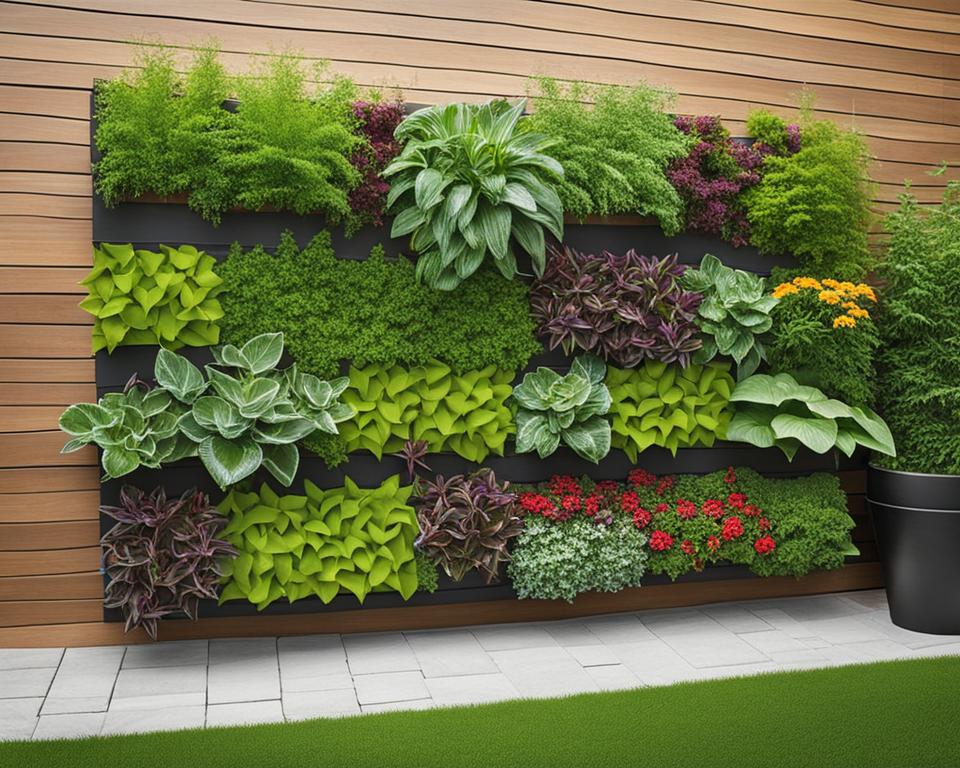Are you a city dweller looking to reconnect with nature and grow your own food? Urban gardening provides the perfect solution for those with limited space and a busy lifestyle. Whether you’re a beginner or an experienced gardener, there are plenty of tips, ideas, and techniques to help you create a thriving garden in your urban environment.
From small space urban gardening to vertical gardening, container gardening to rooftop gardening, there are endless possibilities to transform your urban space into a green oasis. With a little creativity and the right techniques, anyone can enjoy the benefits of urban gardening, even with limited space.
Join me as we explore the world of urban gardening and unlock the secrets to growing your own food, cultivating beautiful gardens, and contributing to a more sustainable future.
Create a Community Garden
Collaborative gardening in shared spaces has become increasingly popular in urban environments. Creating a community garden is a fantastic way to engage with your neighbors, grow fresh produce, and foster a sense of community. By pooling resources, knowledge, and labor, community gardens provide a space for individuals to come together, learn from one another, and contribute to a healthier and more sustainable neighborhood.
When starting a community garden, it’s important to familiarize yourself with the guidelines and rules of the specific shared space. This ensures that everyone is on the same page and can work together smoothly. Additionally, designing the garden to accommodate multiple gardeners is essential. This can be achieved by dividing the space into individual plots or creating communal areas for collective gardening projects.
Collaboration is at the heart of a successful community garden. By organizing regular meetings and establishing clear communication channels, gardeners can share ideas, plan activities, and support each other in their gardening endeavors. Working together not only yields a more bountiful harvest but also strengthens the ties within the community, creating a sense of belonging and empowerment.
“A community garden is not just about growing food; it’s about growing relationships and nurturing a sense of belonging within our shared urban spaces.”
Cultivating Connections Through Gardening
Community gardens have the power to bring people together, fostering a sense of connection and belonging. They provide a platform for individuals to share their knowledge, learn from others, and build relationships. Collaborative gardening projects can include shared harvests, workshops, and community events, which further strengthen the bonds within the neighborhood.
| Benefits of Community Gardens | How to Get Involved |
|---|---|
|
|
Together, we can transform our urban spaces into vibrant and productive havens. By creating community gardens, we not only grow food and beautify our neighborhoods, but we also cultivate connections and make a positive impact on our community and the environment. So, let’s grab our gardening tools and start sowing the seeds of collaboration and growth in our shared spaces.
Design an Urban Rooftop Garden
When it comes to urban gardening, designing a rooftop garden is a popular choice for city dwellers looking to make the most of limited space. Rooftop gardens offer a unique opportunity to create a green oasis in the midst of a concrete jungle. However, there are a few key factors to consider when designing a rooftop garden to ensure its success. From selecting lightweight planters to adhering to rooftop gardening regulations, here are some tips and techniques to help you create a thriving rooftop garden.
Lightweight planters are essential for rooftop gardens due to weight restrictions imposed by buildings. Options such as wooden, fiberglass, or foam planters are ideal choices as they provide support for plants while keeping the overall weight of the garden manageable. It’s important to choose planters that are durable and can withstand exposure to the elements. Additionally, incorporating adequate drainage systems in the planters is crucial to prevent water accumulation and potential damage to the rooftop structure.
Another important consideration is understanding and following rooftop gardening regulations. Before starting a rooftop garden, it’s essential to check with the building or co-op board for any guidelines or restrictions that need to be followed. These regulations may vary depending on the location and building type, so it’s important to comply with them to ensure the safety and legality of your rooftop garden.
With the right lightweight planters and adherence to rooftop gardening regulations, you can create a stunning rooftop garden that not only adds beauty to your urban space but also contributes to a greener environment.
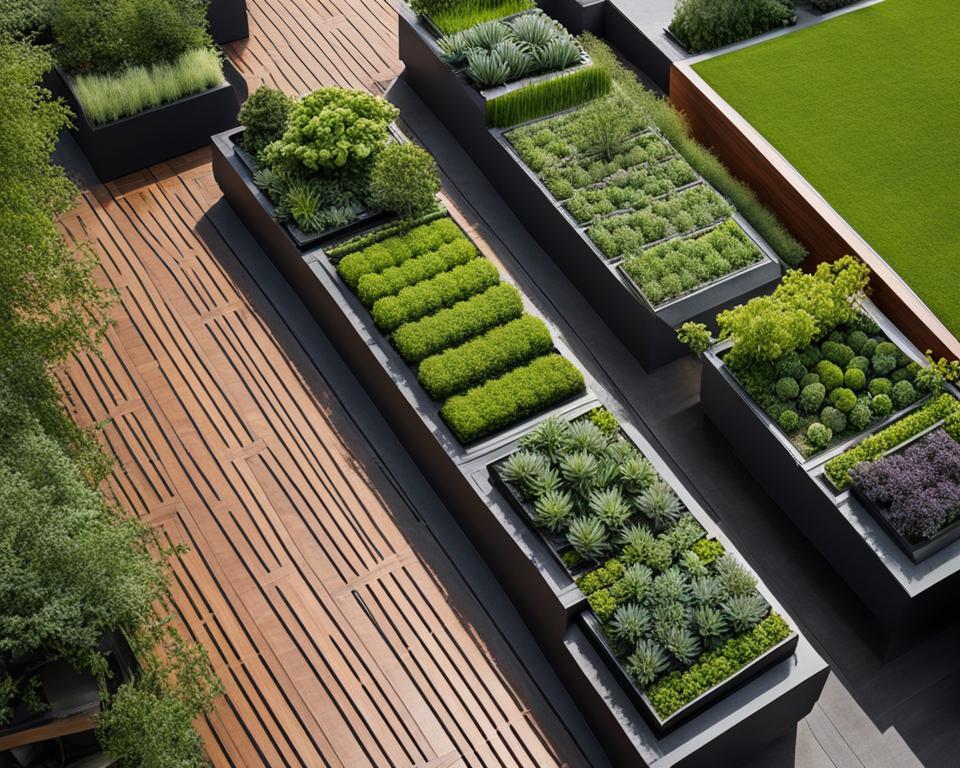
Incorporating adequate air flow is another crucial aspect of rooftop garden design. Since rooftops can be exposed to extreme heat and wind, it’s important to protect your plants by incorporating features like lattices, pallet walls, or trellises. These structures not only provide support for climbing plants but also help to create a microclimate by reducing direct sunlight and wind exposure. By carefully considering these factors, you can create an ideal growing environment for your rooftop garden.
In summary, designing a rooftop garden requires careful planning and consideration. Choosing lightweight planters, adhering to rooftop gardening regulations, and incorporating adequate air flow are essential steps to ensure the success of your rooftop garden. With a well-designed rooftop garden, you can transform your urban space into a thriving green oasis and enjoy the benefits of gardening even in a limited space.
Turn Your Balcony into a Garden
Transforming your balcony into a garden oasis is a fantastic way to utilize small space gardening techniques and enjoy the beauty of nature right outside your door. With the right balcony planters and urban gardening tips, you can create a thriving garden in even the tightest of spaces.
One of the key considerations when starting a balcony garden is choosing the right balcony planters. Opt for lightweight options that won’t overload your balcony’s structural capacity. Hanging planters, vertical planters, and railing planters are great choices that maximize space and allow for vertical growth.
A variety of plants can thrive in balcony gardens, from ornamental flowers to herbs and vegetables. Choose plants that are suitable for your balcony’s sunlight conditions and provide proper care to ensure their growth and health. Consider using a combination of flower planters and herb or vegetable planters to create a visually appealing and functional garden.
Remember to regularly water and fertilize your plants, as containers tend to dry out more quickly than traditional gardens. With a bit of care and attention, your balcony garden can provide a peaceful retreat and a source of fresh herbs, flowers, or even homegrown vegetables.
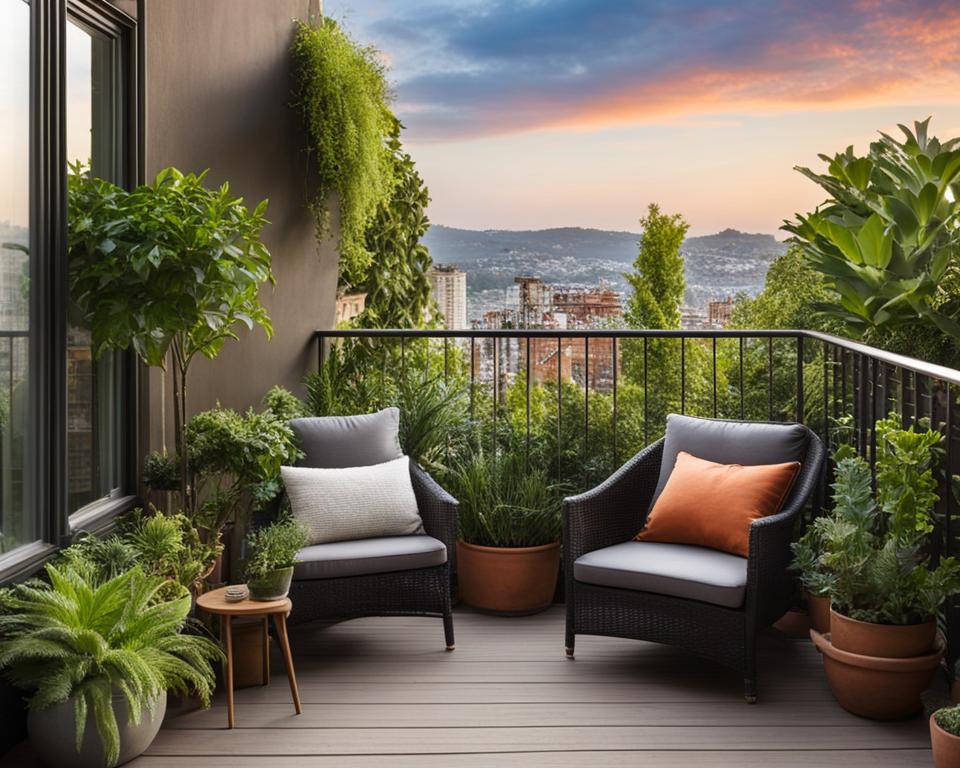
| Planter Type | Pros | Cons |
|---|---|---|
| Hanging Planters | – Maximizes vertical space – Allows for trailing plants – Easy to install and maintain |
– Limited planting space – Requires regular watering |
| Vertical Planters | – Ideal for small balconies – Provides vertical growth opportunities – Can be customized and expanded |
– Limited soil volume – Requires careful watering and maintenance |
| Railing Planters | – Utilizes unused space on railings – Easy to install and access – Allows for a variety of plant sizes |
– Limited planting depth – May require additional support for heavier plants |
No matter the size or layout of your balcony, with a little creativity and the right balcony planters, you can create a stunning garden retreat that brings the beauty of nature into your urban space.
Opt for a Container Garden
If you have limited outdoor space but still want to enjoy the benefits of gardening, a container garden is the perfect solution for you. Container gardens are versatile, allowing you to grow a variety of plants in pots, barrels, boxes, or even buckets. With the right techniques and supplies, you can create a thriving garden in small spaces like patios, balconies, or rooftops.
When choosing containers for your garden, it’s important to consider the size and material. Make sure the containers have enough room for the plants to grow and proper drainage to avoid waterlogging. You can get creative and repurpose items like old buckets or wooden crates as containers. Additionally, investing in high-quality container gardening supplies such as nutrient-rich soil, organic fertilizers, and watering tools will help your plants thrive.
One of the advantages of container gardening is its portability. You can easily rearrange your containers to optimize sunlight exposure or move them indoors during extreme weather conditions. This flexibility allows you to experiment with different plant combinations and designs, creating a beautiful and personalized garden that suits your taste.
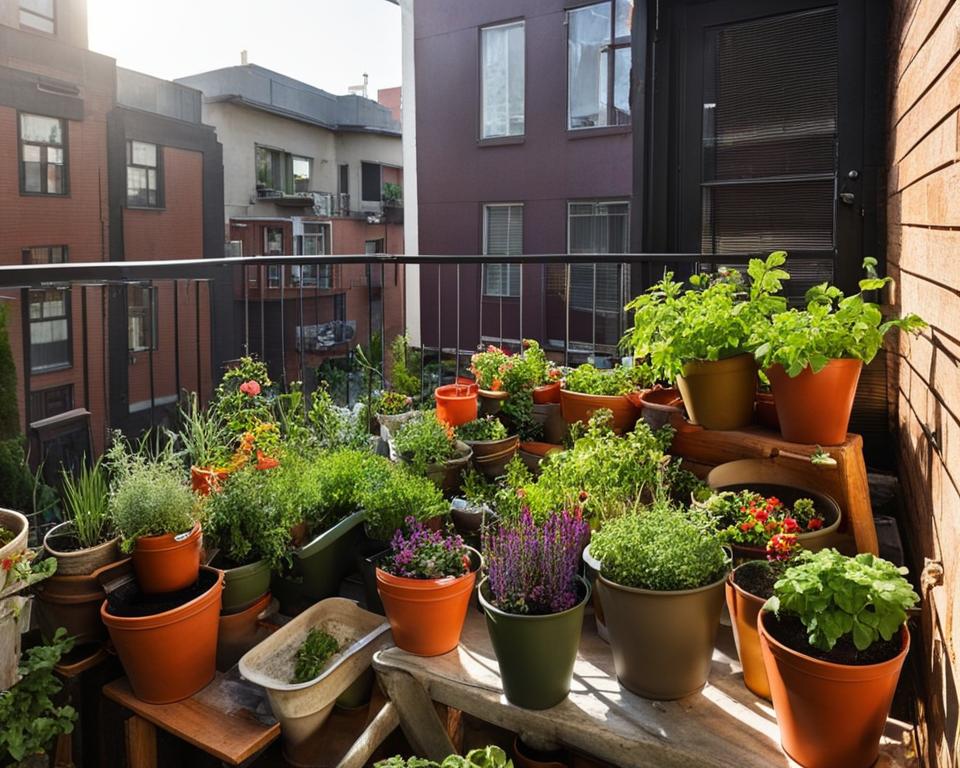
Container Gardening Tips:
- Choose containers with proper drainage to prevent waterlogging.
- Select plants that are suitable for the size of your containers and the available sunlight.
- Use high-quality potting soil and organic fertilizers to promote healthy growth.
- Water your container garden regularly, keeping in mind the specific needs of each plant.
- Rotate your containers to optimize sunlight exposure and prevent plants from leaning towards the light.
With a container garden, you can enjoy the beauty and benefits of gardening even in the smallest urban spaces. Whether you’re growing vibrant flowers, fresh herbs, or delicious vegetables, container gardening allows you to unleash your creativity and connect with nature right at your doorstep.
Build Your Own Mini Greenhouse
When it comes to urban gardening, one of the challenges we face is limited outdoor space. However, that doesn’t mean we can’t create our own mini greenhouse to grow a variety of plants all year round. A mini greenhouse is a compact and efficient solution for city dwellers who want to indulge in indoor gardening and have a green oasis in their homes.
Creating your own mini greenhouse is easier than you think, and it can be a fun DIY project that allows you to customize the design to suit your space and style. To start, you’ll need a few basic materials like clear plastic or glass panels, PVC pipes or wooden frames, and weatherproof adhesive. These items can be easily found at your local hardware store or online.
Once you have the materials, you can begin assembling your mini greenhouse. Start by constructing the frame using the PVC pipes or wooden frames, ensuring it’s sturdy enough to support the weight of the panels. Then, attach the clear plastic or glass panels to the frame, sealing the edges with weatherproof adhesive to keep the greenhouse airtight.
When positioning your mini greenhouse, it’s important to place it in an area that receives plenty of sunlight, such as near a window or on a balcony. This will provide the necessary light for your plants to thrive. Additionally, consider adding shelves or hanging planters inside the greenhouse to maximize space and create different levels for your plants.
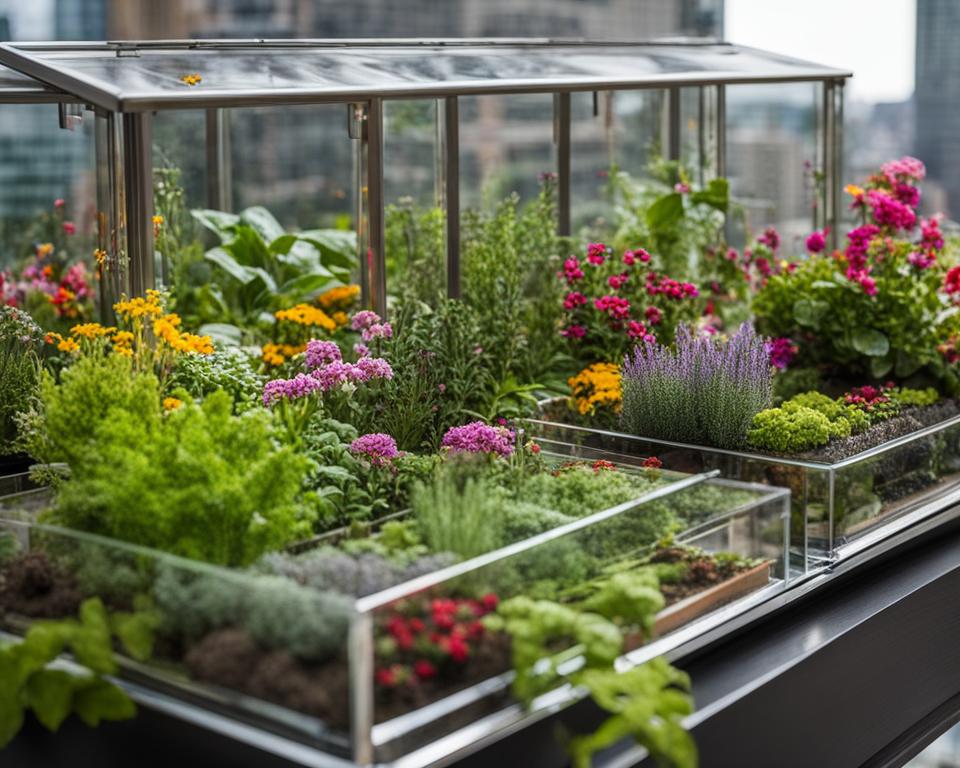
| Benefits of a Mini Greenhouse | Tips for Maintaining a Mini Greenhouse |
|---|---|
|
|
Creating your own mini greenhouse not only allows you to indulge in your love for gardening but also provides numerous benefits. It allows you to grow a wide variety of plants year-round, protects them from pests and harsh weather conditions, and creates a controlled environment for optimal growth. With a little creativity and regular maintenance, your mini greenhouse can become a thriving ecosystem right in your own home.
Conclusion:
With limited outdoor space, building your own mini greenhouse is a fantastic way to enjoy indoor gardening and bring nature into your city dwelling. It allows you to grow a variety of plants all year round, while also protecting them from pests and harsh weather conditions. By following some simple tips for maintenance, your mini greenhouse can become a thriving and beautiful addition to your urban space.
Grow a Vertical Garden
If you have limited space but still want to enjoy the beauty of a garden, vertical gardening is the perfect solution. It allows you to maximize your vertical space by utilizing walls, fences, or specially designed vertical planters. Vertical gardens not only add a touch of green to your urban environment but also provide numerous benefits such as improved air quality, increased privacy, and the opportunity to grow a wide variety of plants.
When creating a vertical garden, there are a few important tips to keep in mind. First, choose the right plants for your specific conditions. Consider factors like sunlight exposure, wind levels, and available space. Opt for plants that thrive in a vertical environment, such as climbing vines, trailing flowers, and compact herbs. Additionally, make sure to provide adequate support for your plants. This can be done through trellises, stakes, or wire grids.
“Vertical gardens not only add a touch of green to your urban environment but also provide numerous benefits such as improved air quality, increased privacy, and the opportunity to grow a wide variety of plants.”
DIY vertical gardens can be easily constructed using recycled materials like wooden pallets or repurposed shoe organizers. These materials are not only cost-effective but also environmentally friendly. Alternatively, there are ready-to-assemble vertical garden kits available in the market, which provide a hassle-free way to start your vertical garden journey.
Vertical Gardening Techniques
There are several vertical gardening techniques you can explore to enhance the aesthetics and functionality of your vertical garden:
- Living walls: Create a lush green living wall by planting a variety of plants directly into a vertical planter. This adds a stunning focal point to any outdoor space.
- Hanging baskets: Utilize hanging baskets to bring color and life to your vertical garden. Choose trailing plants that will cascade down, adding depth and visual interest.
- Stacked pots: Arrange pots of different sizes vertically, starting with the largest at the bottom. This creates a tiered effect and allows you to grow multiple plants in a small space.
- Trellises and frames: Install trellises or frames against a wall or fence to support climbing plants. This technique adds height and verticality to your garden while providing a structure for plants to grow.
Table: Popular Plants for Vertical Gardens
| Plant | Light Requirements | Watering Needs | Growth Habit |
|---|---|---|---|
| Ivy | Partial shade to full sun | Moderate | Climber |
| Spider Plant | Bright indirect light | Low | Trailer |
| Petunia | Full sun | Moderate | Trailer |
| Herbs (Basil, Thyme, Rosemary) | Full sun | Moderate | Compact |
Arranging a Rain Gutter Garden
If you’re an urban gardener with limited space or a desire for portability, a rain gutter garden is the perfect solution. This DIY gardening method allows you to grow a wide variety of plants in a compact, cost-effective manner. With just a few materials and some creativity, you can transform any vertical surface into a thriving garden.
One of the key advantages of a rain gutter garden is its portability. Whether you’re renting a small apartment or planning to move in the future, this type of garden can easily be taken down and set up elsewhere. By attaching rain gutters to fences, railings, or using them as hanging gardens, you can make the most of your available space.
Creating a rain gutter garden is a simple DIY project. Start by purchasing rain gutters from your local hardware store, ensuring they are made from durable materials such as PVC. Cut the gutters to your desired length, and then attach end caps to prevent soil from spilling out. Drill holes at regular intervals to allow for drainage.
Once your rain gutter garden is set up, you can fill it with soil and start planting. This type of garden is perfect for small space gardening, as it takes advantage of vertical surfaces that might otherwise go unused. You can grow a variety of plants, including herbs, strawberries, lettuce, and even small flowers.
With a rain gutter garden, you can enjoy the benefits of gardening no matter how small your space may be. It’s a cost-effective and portable option that allows you to exercise your green thumb and beautify your urban environment. So why not give it a try and create your own rain gutter garden today?
Start an Indoor Herb Garden
Are you a city dweller without access to outdoor space? Don’t worry, you can still enjoy the benefits of gardening by starting your own indoor herb garden. Not only will you have fresh herbs at your fingertips for cooking, but you’ll also add a touch of nature to your living space. Here are some urban gardening tips to help you get started with your indoor herb garden.
Choose the Right Location
When setting up your indoor herb garden, it’s important to choose the right location. Herbs require at least six hours of sunlight each day, so place your herb pots near a bright window. If you don’t have access to natural sunlight, you can use grow lights to provide your herbs with the necessary light.
Select the Right Herbs
Not all herbs thrive indoors, so it’s essential to select the right herbs for your indoor garden. Some popular choices include mint, rosemary, basil, and thyme. These herbs are relatively easy to grow and are versatile in their culinary uses. Remember to choose herbs that you enjoy using in your cooking.
Provide Proper Care
Just like outdoor gardens, indoor herb gardens require proper care to thrive. Ensure that your herbs are planted in well-draining pots with good quality soil. Water your herbs regularly, but avoid overwatering as it can lead to root rot. Additionally, consider using organic fertilizers to provide nutrients to your herbs. Prune your herbs regularly to encourage growth and prevent them from becoming leggy.
By following these indoor gardening tips, you can create a thriving herb garden in even the smallest of spaces. Enjoy the convenience of having fresh herbs at your fingertips and the beauty of nature in your urban home.
Conclusion
Urban gardening provides innovative solutions for city dwellers looking to embrace sustainable agriculture and reap the benefits of growing their own food. With a variety of urban gardening techniques available, such as community gardens, rooftop gardens, container gardens, and indoor gardens, anyone can become an urban farmer, regardless of their living situation.
By engaging in urban gardening, individuals can contribute to a more sustainable world by reducing their carbon footprint through local sourcing and minimizing food waste. Additionally, urban gardening offers numerous benefits, including increased access to fresh and nutritious produce, improved mental and physical well-being, and fostering a sense of community through shared gardening spaces.
Whether you have a small balcony, a rooftop, or even just a windowsill, there are urban gardening solutions that can be tailored to suit your urban environment. Get your hands dirty, embrace the joys of gardening, and make a positive impact on your community and the environment. Start your urban gardening journey today and experience the rewards of cultivating your own sustainable oasis.
FAQ
What is urban gardening?
Urban gardening refers to the practice of growing plants, including vegetables, herbs, and flowers, in urban environments such as cities and towns.
Why is urban gardening important?
Urban gardening is important because it allows city dwellers to grow their own food, create beautiful garden spaces, increase access to fresh produce, reduce carbon emissions through local sourcing, and foster community engagement.
What are the benefits of community gardens?
Community gardens provide fresh produce in “food deserts,” engage neighbors in collaborative gardening efforts, and foster a sense of community and teamwork.
How can I start a rooftop garden?
To start a rooftop garden, you should familiarize yourself with regulations and guidelines set by the building or co-op board, use lightweight planters, and incorporate adequate air flow to protect plants from extreme heat and wind.
What options are there for balcony gardening?
For balcony gardening, you can use container pots, hanging or vertical planters, and pallet walls to transform your space into a garden paradise.
What do I need for a container garden?
For a container garden, you will need containers with proper drainage, gardening supplies like soil and fertilizer, and watering tools. Double-potting plants can help keep them cool and watered on hot days.
How can I build a mini greenhouse?
You can build a mini greenhouse using lightweight materials like PVC pipes or repurposed shelves. This allows you to grow a variety of plants year-round, both outdoors and indoors.
What is vertical gardening?
Vertical gardening involves growing plants vertically, using techniques such as allowing vines to grow along walls or utilizing hanging vertical planters. This maximizes space and creates visually appealing green spaces.
How can I arrange a rain gutter garden?
Rain gutter gardens are created using rain gutters on fences, railings, or as hanging gardens. They are portable and cost-effective options for urban gardeners with limited space or plans to move in the future.
How can I start an indoor herb garden?
To start an indoor herb garden, utilize bright windows and hanging planters. You can grow herbs like mint, rosemary, basil, and thyme indoors and enjoy fresh herbs for cooking.

